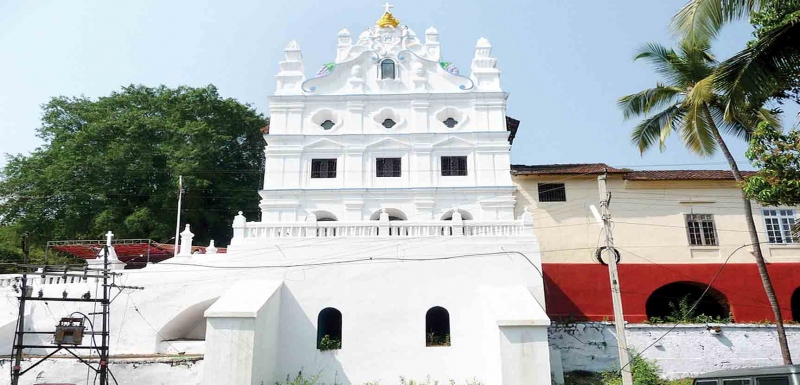
The village of Pomburpa has a peculiar location. It is sandwiched between Aldona, Ucassaim and Nachinola to the north, Salvador do Mundo to the south, Socorro to the west and an outlet of river Mandovi leading to Mapusa to the east. The Church here is dedicated to Our Lady of Mother of God, Nossa Senhora Mae de Deus Igreja em Pomburpa, in Portuguese, popularly known as Our Lady of Candela or Our Lady of Candelaria.
There are two different theories regarding the establishment of the church here. One theory says that it was founded in 1590 by two Franciscan Tertiaries, Luisa da Madre de Deus and Ana de Santa Maria, a daughter and a mother. The Church was donated by them to the Franciscans on June 11, 1604.
Others say that it was in founded in 1628. It is recorded that many Fidalgos and ladies of the Third Franciscan Order (laymen) also donated real estate, gold and jewels to the church.
The Church, besides the main altar dedicated to Our Lady of Candelaria, has three other altars, namely that of St Anthony, Holy Family and Sacred Heart. The church feast is celebrated on February 2, the feast of the Purification of Our Lady.
The feast is known by a peculiar name ‘Pompurbechim Festam Ghoribank Nhoi’ (Pomburpa festivals are not for the poor) or ‘Goribanchea porank him Pompurbechim festam nhoim’ (These Pomburpa feasts are not for the children of the poor).
LEGENDS
In the past, Pomburpa village was inhabited by many Fidalgos besides the locals, who were fishermen, bamboo basket weavers, carpenters. The Fidalgos resided in big palatial bungalows, which are now said to be in ruins or taken away by others. These were located beyond the present church up to two or three kilometres. Their lifestyle differed in many ways when compared to that of the locals, who were poor and hence, worked for them doing odd jobs.
The land beyond the present church, now with a school and a row of houses, was an open land in the past, so say the present elders of the village. There was a ‘kaccha’ (rough) road in the village which led to the church. There was a similar road down below river passing by. On the other side of the river is the Chorao island. This island too had many fidalgos.
The Pomburpa Church feast of Our Lady of Candelaria was a big event in those days. A big fair was laid out at the feast, where vendors, who sat on both sides of the road, sold a variety of items, such as furniture, brass vessels, food items. The fair was visited by both – the locals and the fidalgos, hence the vendors would make brisk business.
The Fidalgos of Pomburpa, elegantly dressed, would come for the fair galloping on horseback or in horse-drawn carriages and the slaves that followed them closely, sheltered them from the sun with fine damask umbrellas. The noble ladies too were carried for the fair in luxurious Machillas. These would come either for entertainment or to make purchases of basic necessities. The Fidalgos from Chorao Island would also join them.
It is believed that on one occasion when they came for the fair on horseback, a poor child ran across the road. The child was run over and trampled to death by some galloping horses. This unfortunate event brought a lot of despair among the locals.
In future, they decided either not to attend the feast fair or not to send their children for the fair. Hence, the Church feast got this name ‘Pompurbechim Festam Ghoribank nhoi’ (The Pomburpa Festivals are not for the Poor) or ‘Pomburpachem Fest Ghoribachem bhurgeak nuim’ (The feast of Pomburpa is not meant for the children of the poor).
(The writer is former director of Thomas Stephens Konknni Kendr at Porvorim)